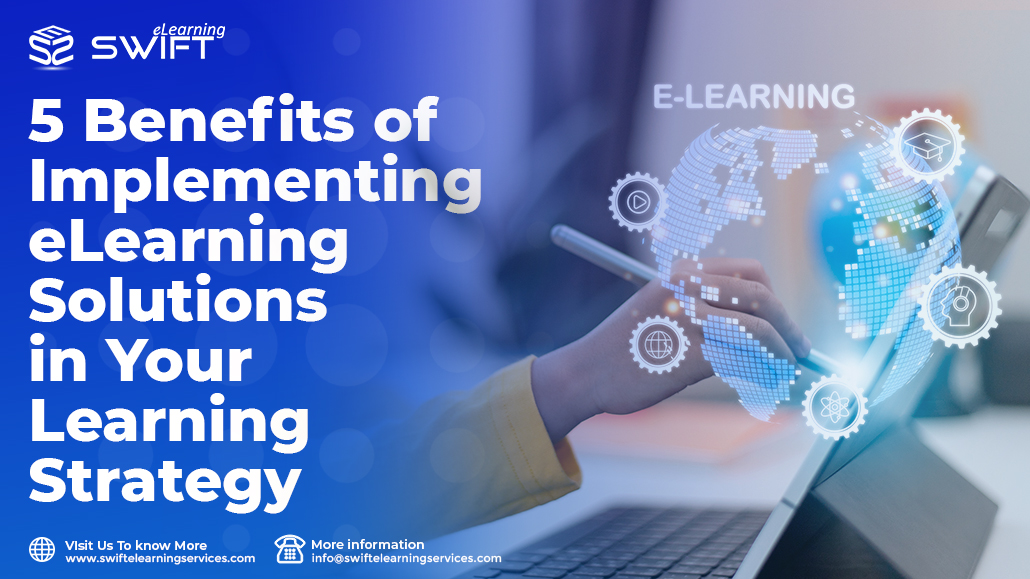5 Benefits of Implementing eLearning Solutions in Your Learning Strategy
In today’s fast-paced world, where information is readily available at our fingertips, traditional methods of learning are rapidly evolving. One of the most significant transformations in the field of education and corporate training is the adoption of eLearning solutions. These digital platforms have revolutionized the way we acquire knowledge and skills, offering numerous advantages over traditional classroom-based learning.
In this blog post, we will explore five key benefits of implementing eLearning solutions in your learning strategy.
1. Flexibility and Accessibility
One of the most significant advantages of eLearning solutions is the flexibility they offer. Traditional learning methods often require students or employees to be physically present in a specific location at a set time, which can be inconvenient and limiting. In contrast, eLearning allows learners to access educational content from anywhere in the world and at any time that suits them.
This flexibility is particularly valuable for individuals with busy schedules, working professionals, and those juggling multiple responsibilities. Whether you’re a student trying to balance coursework with a part-time job or a professional looking to up skill while working full-time, eLearning accommodates your needs. It enables you to learn at your own pace and on your own terms, eliminating the need to commute to a physical location and providing the freedom to create a personalized learning schedule.
Furthermore, eLearning solutions are accessible to a diverse audience, including individuals with disabilities. Many eLearning platforms are designed with accessibility in mind, offering features such as closed captioning, screen readers, and adjustable font sizes, ensuring that everyone can participate in the learning process.
2. Cost-Efficiency
Implementing eLearning solutions can lead to significant cost savings compared to traditional classroom-based training. Traditional education and training methods often involve expenses such as renting physical spaces, purchasing textbooks or training materials, and travel costs. In contrast, eLearning eliminates many of these expenses.
With eLearning, you can create and deliver training content digitally, reducing the need for physical resources. Course materials can be updated and distributed online, eliminating printing and distribution costs. Additionally, eLearning platforms often have scalable pricing models, allowing organizations to pay only for the number of users or courses they need. This scalability is particularly advantageous for businesses that want to train a large workforce or for educational institutions looking to reach a broader audience without incurring exorbitant costs.
Moreover, eLearning reduces indirect costs associated with traditional learning, such as travel time and accommodation expenses. This makes eLearning a cost-effective solution for both businesses and educational institutions, enabling them to allocate resources more efficiently and invest in improving the quality of their content and learning experiences.
3. Personalized Learning Experiences
One-size-fits-all approaches to education and training often fall short in meeting the diverse needs and learning styles of individuals. ELearning solutions address this challenge by offering personalized learning experiences.
Through eLearning platforms, learners can choose courses that align with their interests, goals, and skill levels. Many platforms use algorithms and data analytics to recommend courses and content tailored to each learner’s preferences and progress. This personalization not only enhances engagement but also ensures that learners receive the most relevant and effective training.
Additionally, eLearning allows learners to proceed at their own pace. If a learner struggles with a particular concept, they can revisit the material as many times as needed until they grasp it. Conversely, if a learner quickly grasps a topic, they can move on to more advanced content without waiting for the rest of the class to catch up.
In a corporate context, personalized eLearning can be particularly beneficial. It enables organizations to create training programs that address the specific needs and skill gaps of individual employees, enhancing their job performance and contributing to the company’s overall success.
4. Enhanced Engagement and Retention
Engagement and knowledge retention are critical factors in effective learning. ELearning solutions incorporate various interactive elements and multimedia tools that significantly enhance engagement and retention compared to traditional methods.
Video tutorials, interactive quizzes, gamified learning experiences, and simulations are just a few examples of the engaging features commonly found in eLearning courses. These elements make the learning process more enjoyable and memorable, as they cater to different learning styles and preferences.
Furthermore, eLearning leverages the power of multimedia, enabling learners to absorb information through various senses. Visual aids, audio narration, and interactive graphics can convey complex concepts more effectively than text alone. Studies have shown that multimedia-rich content can improve comprehension and long-term retention of information.
Additionally, eLearning platforms often include social learning features, such as discussion boards and collaborative projects. These tools encourage learners to interact with peers, ask questions, and share insights, fostering a sense of community and enhancing the learning experience.
5. Real-time Tracking and Assessment
Assessing the progress and performance of learners is essential for both educational institutions and businesses. Traditional assessment methods, such as written exams or in-person evaluations, can be time-consuming and prone to bias.
ELearning solutions, on the other hand, provide real-time tracking and assessment capabilities that offer numerous advantages.
ELearning platforms can track learners’ progress throughout a course, monitoring their completion of modules, scores on quizzes and assignments, and time spent on each topic. This data allows instructors and administrators to identify struggling learners early and provide targeted support.
Additionally, eLearning platforms often offer automated assessment tools that can grade assignments and quizzes instantly, saving instructors valuable time. These tools can provide detailed feedback to learners, helping them understand their strengths and weaknesses and guiding them toward improvement.
From a business perspective, real-time tracking and assessment can help organizations gauge the effectiveness of their training programs. By analyzing data on learner performance and engagement, companies can identify areas where additional training is needed and make informed decisions about resource allocation.
6. CONCLUSION
Implementing eLearning solutions in your learning strategy offers a wide range of benefits, including flexibility, cost-efficiency, personalized learning experiences, enhanced engagement and retention, and real-time tracking and assessment.
Whether you’re an educational institution looking to modernize your curriculum or a business aiming to improve employee training, eLearning can help you achieve your goals more effectively and efficiently.
As technology continues to advance, the eLearning landscape will continue to evolve, offering even more innovative and effective ways to acquire knowledge and skills. Embracing eLearning as a fundamental component of your learning strategy is not just a trend; it’s a strategic investment in the future of education and training.
Frequently Asked Questions (FAQs)
What is eLearning, and how does it work?
ELearning, or electronic learning, refers to the use of digital technology to deliver educational or training content. It involves online courses, interactive modules, and multimedia materials that learners can access via computers, tablets, or smartphones. ELearning often includes videos, quizzes, and other interactive elements to engage learners effectively.
How does eLearning compare to traditional classroom learning?
ELearning offers greater flexibility, cost savings, and personalized learning experiences compared to traditional classroom learning. Learners can access eLearning materials from anywhere at any time, reducing the need for physical resources and accommodating diverse learning styles and preferences.
Can eLearning be tailored to individual needs and skill levels?
Yes, eLearning can be highly personalized. Many eLearning platforms use algorithms to recommend courses and content based on learners’ interests, goals, and progress. Learners can also proceed at their own pace, revisiting material as needed or advancing quickly through topics they grasp.
How does eLearning enhance engagement and retention?
ELearning leverages interactive elements, multimedia, and gamified experiences to make learning more engaging and memorable. These features cater to different learning styles and utilize multimedia to improve comprehension and long-term retention of information. Social learning tools also foster a sense of community and interaction among learners.
How does eLearning facilitate real-time tracking and assessment?
ELearning platforms provide real-time tracking of learners’ progress, including completion of modules, quiz scores, and time spent on topics. Automated assessment tools can instantly grade assignments and quizzes, offering detailed feedback to learners and helping instructors identify areas that may need additional attention.
Is eLearning suitable for both educational institutions and businesses?
Yes, eLearning is versatile and can benefit both educational institutions and businesses. It can modernize curriculum delivery in schools and universities and improve employee training and development in the corporate world. Its adaptability and cost-efficiency make it a valuable tool for various learning environments.










Leave a Reply
Want to join the discussion?Feel free to contribute!